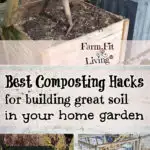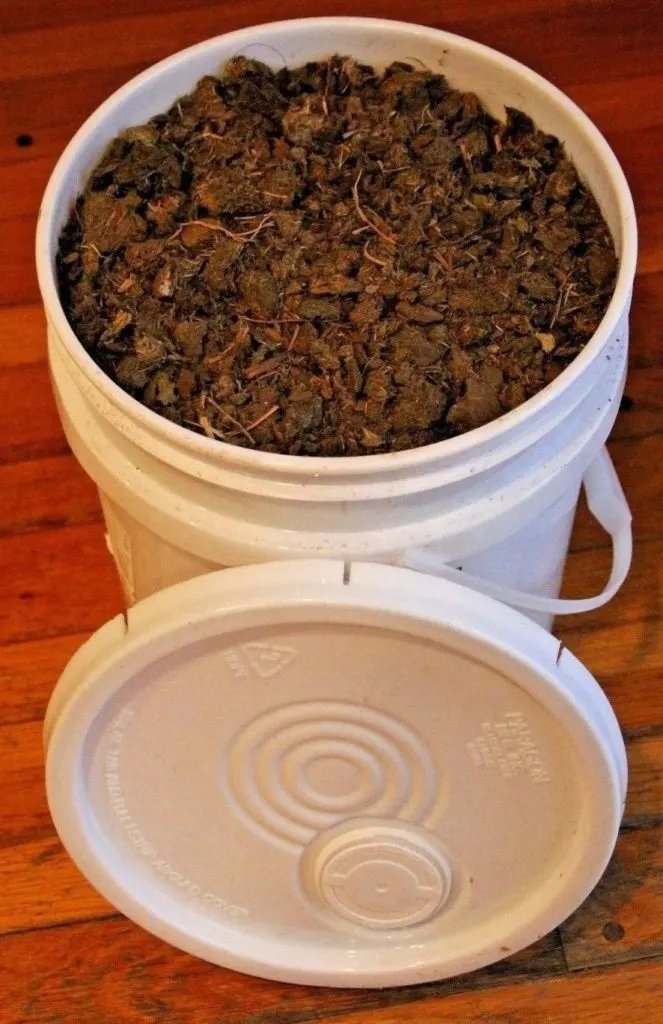These best composting hacks will help improve the fertility of your soil to help you grow amazing garden plants.
Best composting hacks for building great soil is the most important foundation needed to grow a great garden. Think of it this way. Can you function and grow in your day-to-day without a good night’s sleep?
The answer is, of course, no! Sleep, rest, and living comfortably is a vital need that we all crave. Of course, we can relate to this. And our plants need the same type of environment to grow in and thrive as well.
Also, if nothing is growing where you are because your soil isn’t the best, guess what? You can change it! You have the power. There are some things you need to do to figure out what’s in your soil and what it needs to build up.
In this post, I will explain:
– Several best composting hacks that will help you build that great soil.
– What and what not organic materials to add into your compost bin.
– Info for soil building and best composting hacks that not a lot of other gardeners do that will make a difference for you.
This post contains Affiliate Links. This means if you click and buy, I might make a commission at no cost to you.
See my policy for more information
Listen to the Podcast Episode:

Why Compost?
What are the main reasons for choosing compost? Well, I’ve mentioned above that it’s a great way to enrich your soil in a natural way. That’s the biggest reason.
However, the deeper reason for composting is that it’s a great way to use waste from your kitchen or yard. In a moment, I’ll list some items that work great in your compost bin.
The end goal is to build up your soil to make it more productive. That is the main reason why people compost. It’s a great way to use waste for a bigger use later on. It’s the circle of life that is sustainable and environmentally friendly. Who doesn’t love that?
Are you intrigued? Let’s get into what composting is and exactly what it can do to your garden soil.
What is Composting?
Compost is simply defined as the ultimate soil amendment. You can use it as a soil amendment, but you can also use it as a mulch or a top dress for your lawn with the goal of greener grass!
Essentially, you’re feeding the soil with the compost. Did you know that soil contains beneficial microorganisms? Remember the perfect bed I mentioned above? These microorganisms help keep that perfect bed fertile, but they need to be fed, too.
As these microorganisms break down and enjoy the compost you work into the soil, they release nutrients back into the soil. And that’s what the plants can absorb helping them to be fed, too.
Best composting hacks not only provides nutrients but it also increases the water holding ability and makes the soil nice and fluffy. Again, what’s not to love about compost?
It gives so much to the soil and to the plants but it also keeps useful materials, such as leaves and branches from being disposed into landfills. And another plus is that it’s enjoyable and interesting to watch.
Now that you’re excited about your compost heap and what it can do for your garden, let’s talk about how to make it.
Best Composting Hacks: How to Make Compost
So, compost is essentially a mixture of soil and rotted, decomposed organic matter that will be transformed into rich and crumbly organic matter. The most important thing to keep compost healthy is to make sure bacteria, fungi, microorganisms are healthy.
Healthy compost needs air and water moving through it to help break it down. It helps to return organic matter to the soil in a usable form so that you can use it on your garden.
Another thing to know about compost is what and what NOT to put into it. Great compost needs a 2:1 ratio of Carbon and Nitrogen items respectively to fuel the activity of the decomposers I mentioned above (bacteria, fungi, etc). These are also known as green (N) and brown (C) items.
The best way to achieve this ratio is to layer items in, alternating green materials and brown materials with a layer of soil. Sort of like making lasagna.
So, what’s happening scientifically? Well, you have your nutrients in there in your N and C but the soil acts like a rising agent. Microorganisms love the extra soil to help get the magic happening. It’s also important to keep in mind: To only add enough water to keep the moisture level similar to a wrung-out sponge. Continue to layer the pile in the order you choose but it’s so important to keep in mind that air must be able to go all through the pile.
I have posts that I will link to below about that green and brown composting material but I’ll briefly list the items next.
Green Compost Material (Nitrogen)
When you use fresh green material, make sure it’s weed and chemical free so that it doesn’t affect the organisms of your compost.
– Egg Shells
– Kitchen scraps, such as Vegetable Scraps
– Food Scraps
– Coffee Grounds or tea bags
– Farm Animal Manure
– Grass Clippings
– Hair
Check out the post below in the related posts section for this post where I really go deep into what green compost is and how it works.
Brown Compost Material (Carbon)
While brown seems to be boring, you actually need more of these items in your compost bin. Here’s a short list of what these materials include:
– Yard waste, such as Leaves or lawn clippings
– Garden waste, such as Straw
– Paper
– Shredded Tree Branches
– Stalks
– Pine Needles
– Nut Shells
– Dryer Lint.
Like green compost, I have a whole other post on the brown side of compost. Check it out below. And please realize you need a 2:1 ratio of Carbon to Nitrogen for the composting process to be successful. Both of them together make amazing compost for your home garden.
How to Keep Compost Items
Before you start a compost pile, you need somewhere to keep it. The pile needs to be in a level, well-drained area that is easy to get to because you’ll need to check it regularly.
Wherever you place your compost pile is up to you. Remember, it needs to have plenty of air and access to water. You can keep it a secret and put it in a corner of your yard. Or you can place the bin close to where materials are accessible or close to where your garden is.
How big should your compost pile be? Ideally, it should be uniform square and 3 feet by 3 feet is the norm. These dimension has a lot to do with how the compost pile will decompose as quickly as possible.
The 3 X 3 feet size is big enough for the pile to heat up and small enough to easily manage. Anyone can turn compost in a pile this size easily. Piles bigger than this, doesn’t generally allow enough air to reach the center of the pile. Remember – This is important as well.
It’s really important to remember the Carbon to Nitrogen ratio of 2:1 and to allow the entire pile to get plenty of air and moisture. Let’s talk about what NOT to put into that compost pile.

What NOT to Put Into Your Compost Bin
I’ll bet you’re wondering what NOT to include in your compost bin. Here’s a shortlist:
– Weeds with seeds.
– Poisonous Plants
– Fat, grease or oils from the kitchen.
– Dairy Products.
– Pet Waste
– Meat & Animal Products
– Diseased or insect-infected plants and plant materials
Many of these are for obvious reasons, but in a nutshell, you don’t want weeds, waste or mold growing in your compost. That’s the reason for this list of what not to use.
When is Compost ready to use?
A common question people ask is how long does it take for compost to be ready to use? The answer is: It depends.
Perfect compost is ready to use when it is a dark brown, soil-like substance with a good earthy smell. We know how it’s achieved. Here’s a list of best composting hacks again to make good compost in a quick amount of time:
– Shred or chop materials into smaller pieces.
– Build the pile at the 3 by 3 square foot size.
– Keep track of the moisture.
– Keep track of the air flow by turning the pile every 2-4 weeks consistently or when the compost pile gets hot.
The secret of quicker compost is how hot the compost pile will get. The hotter the pile, the quicker the healthy decomposition. So, the answer to the question of how long is about three to four months if you pay close attention to the pile.
Less attention to detail will produce a cooler pile. The long-term effects will be a compost produced in six months to a year.
Additionally, the smallest pieces of green and brown material, the better. Chop it with a shovel or run it through a lawnmower. This is because it creates more surface areas for the good beneficial microorganisms to work on.
You also need to be aware of pests in your compost. Cover your compost to avoid flies and fence it in or enclose it to prevent animals from getting in.
Following the good steps consistently will lead you to great organic material for your garden spot.
Best Composting Hacks: How to Turn Bad Soil Into Good Soil
If you have trouble growing plants in your soil, the good news is that you can amend it. With a few easy steps, including soil testing and feeding the soil microbials, you can turn your potential garden spot into a productive spot.
For best results, soil testing and fertilizing routinely can help you to build up your soil overtime. It could take one year or several. I have other in-depth posts on the blog all about soil testing, nutrients in your soil and fertilizing – Including the best time and easiest way to do each one of these.
Also, keep in mind that air circulation and water is very important for the success of your compost. You might have all the ingredients, but you need to turn the large pile several times throughout the process. Luckily, there are turning bins you can purchase or you can use a garden fork. As always, there’s plenty of ways to be successful in composting. You just need to create the natural process and use the top tips that work for you.
I hope this post has helped you to learn how to compost easily and effectively. Leave me a comment and check out those other posts!

Make Gardening Simple Now!

Simple gardening equals smart gardening. In this short, easy to read book, you'll get access to all the best practices and tips for gardening smarter and more successfully. If you want more information, I'll send it right to your email inbox!



Bruce
Sunday 3rd of March 2019
I'm truly enjoying the design and layout of your blog. It's a very easy on the eyes which makes it much more pleasant for me to come here and visit more often. Did you hire out a designer to create your theme? Outstanding work!
Mindy Young
Friday 8th of March 2019
Hey, Bruce
I did hire a designer. Thank you for the compliment.